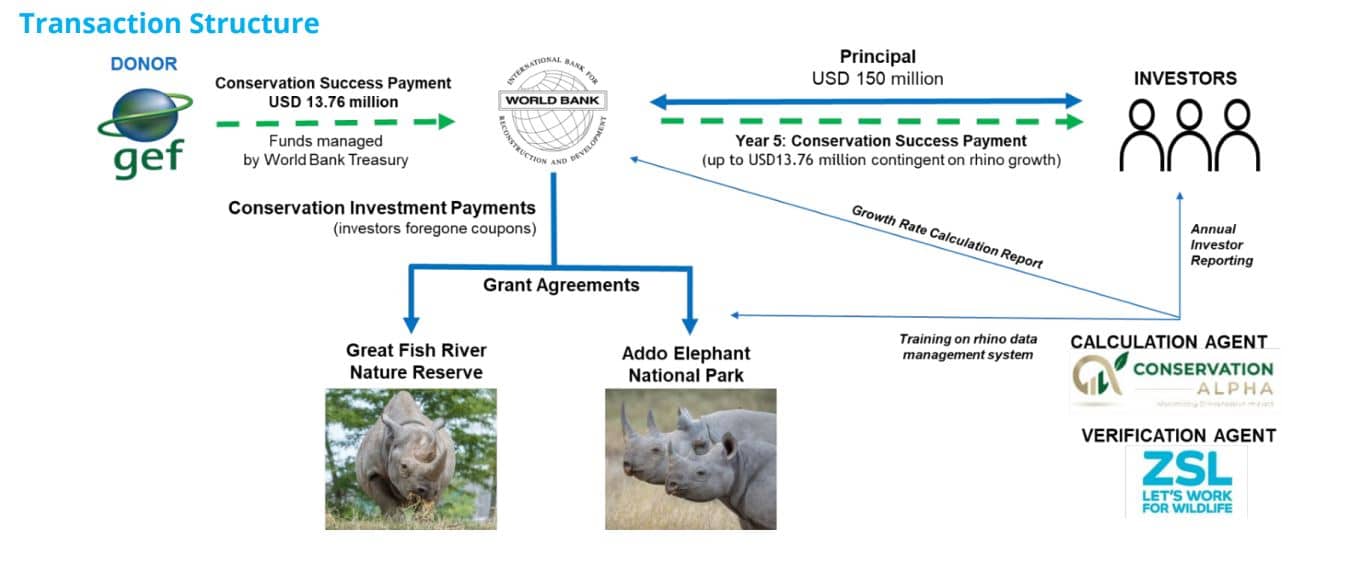| Title | The Wildlife Conservation Bond
‘The Rhino Bond’ |
| Country/Location | South Africa |
| Size | $150 million |
| Revenue Model | Repaid by borrower (IBRD) from general funds |
| Private Investment/Finance Structure | Outcome-based, five-year sustainable development bond – coupons fund rhino conservation and a ‘contingent conservation success payment’ made to noteholders |
| Public/Philanthropic Investment | Grant funding from GEF |
| Env/Social Impact | Rhino population growth, habitat protection, creation and generation of local jobs through tourism |
Summary
The world’s first Wildlife Conservation Bond – also known as ‘the Rhino Bond’ – has been issued by the World Bank to help increase the population of the endangered Black Rhino species in South Africa. $150m was raised from institutional investors, which will go to sustainable programmes ran by the International Bank for Reconstruction and Development (IBRD) around the world. This will generate a return, and instead of a traditional coupon going directly to the investors, $10m will be paid to conservation programmes in South Africa that aim to increase the number of Black Rhinos. Investors’ returns will be determined directly by the population growth over the next five years.
Black rhinoceroses are a critically endangered species and extremely vulnerable to extinction in the wild, mainly due to poaching and habitat loss. In 1970, there were 65,000 black rhino in the wild. As poaching has intensified and pressures on their habitat increased, today only 5,500 remain. Rhinos are also an umbrella species, playing a crucial role in shaping ecosystems on which countless other species depend. These ecosystems also support jobs and critical industries like tourism.
However, combatting rhino poaching and protecting rhino habitats involves constant monitoring that requires significant, long-term funding, which is not always available from conservation donors. Private investment in this area is clearly needed, but until recently, there has been no mechanism to funnel private capital into rhino conservation, or a rigorous means of measuring the outcome.
Six years ago, the Zoological Society of London (ZSL) started the Rhino Impact Investment Project, to eventually develop the world’s first ‘rhino bond’ that ties the return on the up-front investment directly to the rhino population growth it is supporting. This work was undertaken through United for Wildlife, a partnership with six other wildlife charities and The Royal Foundation of the Duke and Duchess of Cambridge.
Developing the Rhino Impact Investment Project
Funding for the project came from the Global Environment Facility (GEF). GEF is a multilateral trust fund dedicated to investing in nature implemented by the United National Development Programme. This is done on behalf of the World Bank, along with Credit Suisse, Oak Foundation, Rufford Foundation, the UK Government through its Illegal Wildlife Trade Challenge Fund, United for Wildlife and ZSL.
The Rhino Impact Investment Project conducted a three-year study, led by ZSL, on the feasibility of outcomes-based financing for rhino conservation in five different rhino conservation locations. These were across South Africa, Kenya and Nepal.
It aimed to increase the population of rhinos in these study locations and developed a methodology for quantifying and verifying the outcome of rhino conservation financing. It also showed that such financing could have other benefits, such as protecting other species living in rhino habitats and improving the lives of people working and living in these areas.
With the help of Credit Suisse, the project then developed the world’s first ‘pay-for-results’ financial instrument for species conservation. The project also received legal, technical conservation and conservation finance support from a host of organizations, including Conservation Alpha, Fauna & Flora International, Kenya Wildlife Service, The Nature Conservancy, UBS and the WWF.
Launch of the Bond
The financial instrument was originally conceived as a development impact bond, a results-based contract funded by private investors, who would receive a return if the population of black rhino grew as a result of the funding. However, it was decided that a public bond would be more popular with investors. In March 2022, the World Bank issued the bond , a five-year $150 million sustainable development bond, through the International Bank for Reconstruction and Development’s (IBRD) global debt issuance facility.
The Wildlife Conservation Bond, also known as the Rhino Bond, includes a conservation success payment made by GEF to noteholders, dependent on verified increases in Rhino numbers. It is the world’s first financial instrument dedicated to protecting a species. Credit Suisse was the sole structurer of the bond and joint bookrunner with Citibank.

James Pilkington, Senior Specialist, Conservation Finance at ZSL
The fact that this was a bond issued by the World Bank gave institutional investors the confidence to participate. The World Bank is a triple-A entity that has been issuing sustainable development bonds in the international capital markets for over 70 years.
“We’ve seen a proliferation of blended finance funds investing in nature-positive projects, but it’s always hard to meet the risk-return profile of institutional investors,” says James Pilkington, Senior Specialist, Sustainable Finance at ZSL, who leads ZSL’s work developing bankable conservation finance projects. “If you look at a lot of impact investments, investors can lose it all, whereas with a bond, you know that you will be getting your principal back. Structuring this as a bond made it a lot less risky for investors, it provided the ticket size that institutional investors require, and having the World Bank issue this was also very important for its credibility.”
Nuveen was the lead investor in the Bond, which was also sold to a mix of other institutional and private investors, including AllianceBernstein, ASN Impact Investors, Azimut Investments, BlueBay Asset Management, INGKA Investments, Mackenzie Investments, and some high net worth clients of Credit Suisse and Citi.
Innovative structure
The Bond’s principal will be used to fund the World Bank’s sustainable development projects and programmes around the world. Instead of making coupon payments to investors, the IBRD will make a series of ‘conservation investment payments’, totalling approximately $10 million, to fund rhino conservation activities and maximise the net rhino growth rate in two of locations studied through the Rhino Impact Investment Project: the Addo Elephant National Park and the Great Fish River Nature Reserve, both in South Africa’s Eastern Cape province.
Great Fish River Reserve and Addo Elephant National Park were selected to receive payments from the bond because together they represent a significant proportion of South Africa’s black rhinos and they have successful rhino conservation efforts already established. At Great Fish River Reserve, for example, vigilant monitoring and surveillance means that not a single black rhino has been lost to poaching. Both locations also have the capacity to absorb a large amount of financing and the ability to grow their rhino populations further. South Africa was also chosen because it had a stable macroeconomic environment that would attract investors.
Tying outcomes to financial returns
Although they are foregoing coupon payments, noteholders will receive a ‘conservation success payment’, up to $13.76 million, based on the net rhino growth rate (the biological growth rate minus the poaching rate) at these two locations over the five-year term of the bond.
If there is no change in the net rhino growth rate, no payment will be made. If the net growth rate is:
- Between 0% and 2%, bondholders will be paid $36.69 per $1000 invested.
- Between 2% and 4%, bondholders will be paid $73.38 per $1000 invested,
- Over 4%, bondholders will be paid $91.73 per $1000 invested.
The net rhino growth rate will be independently calculated in South Africa by Conservation Alpha, from the air and from vehicles on the ground, and verified by ZSL. The success payments to investors will be funded with a performance-based grant from the Global Environment Facility.
“We needed to have a very robust scientific method of demonstrating an increase in rhino abundance,” says Pilkington. “The aim is to have a similar level of confidence in results as carbon credits, and we are using a similar approach but applying this to species abundance.”
The Rhino Bond represents a new, blended finance approach to conservation financing, which maximises the impact of donor funds by channelling them towards conservation outcomes, rather than long-term investments. The Bond also passes the project’s risks to bondholders in return for a potential pay-out if the project is successful.
As co-benefits of the Bond, it is hoped that these conservation efforts will lead to protection of other species living in these habitats, increase biodiversity, and improve ecosystem services like clean water that serve the local citrus industry. The conservation investment payments from the Bond will also support community engagement and over 2000 tourism-based jobs in South Africa’s Eastern Cape province. This was an attractive social outcome as the province’s tourism sector had been badly affected by the COVID pandemic.
What’s next
The partners behind the Rhino Impact Investment Project plan to replicate this model with other rhino populations, similar species under threat and in Protected Areas. Pilkington says that the development of a robust and verifiable system of measuring the conservation impact will also make it easier to attract private funding for different conservation landscapes, through a variety of financial instruments.
Although this is an innovative structure, the ZSL seeks financial instruments that channel the total investment proceeds into these landscapes, not just the coupon payments as in the case of The Rhino Bond. One of the financial instruments that ZSL is exploring are biodiversity credits that protect species.
“The biodiversity credits that are under development are about habitats and ecosystems, but protecting biodiversity requires more than that,” says Pilkington. “There are forests in South East Asia that are still there on paper, but have no large animals because they’ve been poached out. We’re talking to a few partners about a payment-by-results model to see if we can translate that into biodiversity credits that protect species.”
Although new technology can help, one limitation is the species in question. The ZSL is considering a project with orangutans, for example, because they are fairly easy to count, given the relatively high correlation between orangutan nests an population numbers. “With other species like pangolins, it’s very hard to create estimates of population numbers,” says Pilkington.
Another limitation is understanding investor appetite to offset their impact on species. However, he says that new initiatives like the Taskforce for Nature-Related Financial Disclosures that increase awareness of companies’ impacts and dependencies will help.
Overall, he thinks that the more that could be done on the ground to identify and create low-risk projects in species conservation, the more private capital will flow in. “We need more innovation in how to de-risk projects for investors and create certainty about outcomes, returns, permanence and all the things that currently scare investors away from biodiversity,” he says.
Sources:
- Interview with James Pilkington, Senior Specialist, Conservation Finance at ZSL
- ‘Can finance help Africa keep its wildlife?’, Saigal, Euromoney, 2019
- ‘Credit Suisse acts as Sole Conservation Bond Structurer on World Bank’s ‘Rhino Bond” , Credit Suisse, 2022
- ‘Wildlife Conservation Bond mobilizes private capital to protect critically endangered rhinos’, The World Bank, 2022
- ‘Wildlife Conservation Bond Boosts South Africa’s Efforts to Protect Black Rhinos and Support Local Communities’, The World Bank 2022
- https://www.zsl.org/conservation/our-priorities/wildlife-back-from-the-brink/animals-on-the-edge/rhino-impact-investment
